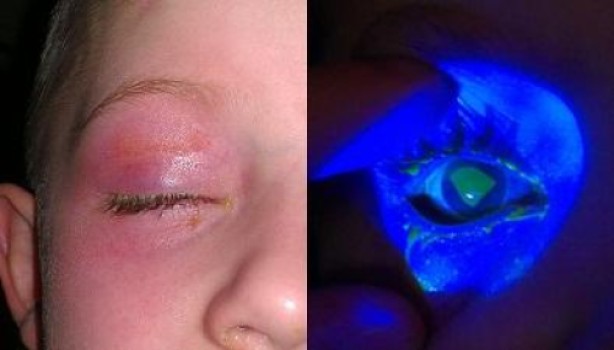
Liquid laundry and dishwasher detergent pods are an emerging source of chemical exposure in children. When squeezed or bitten into, these pods can burst and send detergent into the mouth, nose, and eyes. A new report published in the current issue of the Journal of the American Association for Pediatric Ophthalmology and Strabismus (AAPOS) cautions that these products should be kept away from children because the bursting detergent pods can cause significant corneal injury.
Detergent pods may offer a simpler way to do laundry, but they represent a source of potential danger when in the hands of a young child. Available in the European market for over a decade and first introduced to the American market in 2010, liquid detergent pods are brightly colored, which makes them attractive to young children who mistake them for toys.
Michael E. Gray, MD, and Constance E. West, MD, from the Abrahamson Pediatric Eye Institute at Cincinnati Children’s Hospital Medical Center, began tracking ocular injuries from detergent pods after noticing an increase in patients over the course of several months beginning in 2012. Ten children, all under 4 years of age, were treated for eye injuries stemming from burst detergent pods. Over the same time frame, 21 other children were seen in the emergency room for injuries caused by ingestion of the detergent contained in the pods.
For the children with eye injuries, two cases involved the child biting down on the pod, seven cases resulted from children squeezing the pod in their hands, and in the last case, the cause was unknown. All ten children with eye injuries presented with significantly bloodshot eyes, although no limbal ischemia or clinically significant conjunctival chemosis was found. Corneal abrasions were found in all of the cases, with defect sizes ranging from 3 mm in diameter to a nearly complete corneal epithelial defect. In addition, three children also had mild periorbital edema or erythema ipsilateral to the corneal abrasion.
During ophthalmologic examination, the ocular surface pH was measured and found to be neutral in all cases, but as study co-author Dr. Gray, Pediatric Ophthalmologist and Assistant Professor, Division of Pediatric Ophthalmology at Cincinnati Children’s and UC Department of Ophthalmology, points out, the pH levels among different brands can vary. “Alkaline injury should also be suspected in association with the ocular cases. However, reported pH from Material Safety Data Sheets (MSDS) of different brands of pods is variable. The pH of some brand name pods is close to neutral (6.8 – 7.6), whereas other brands are considerably alkaline (8.0 – 11.0).”
The report also explains that because these pods are designed to be concentrated, they often contain higher levels of surfactants than traditional detergent, making them more likely to cause injury when they are ingested or when the chemicals enter the eye.
In the study, all affected subjects were treated with irrigation and topical antibiotic ointment. The recovery period for the children averaged just under four days, and none of the patients experienced additional complications or relapse.
While makers of these detergent pods have made changes to packaging to try to keep children out, not all brands adhere to the same safety standards. “Manufacturers have taken steps to prevent such injuries, such as warning labels and container lid safety features,” states Dr. West, Pediatric Ophthalmologist and Associate Professor, Cincinnati Children’s and UC Department of Ophthalmology. “These safety features are not always present, however, particularly with off-brand or generic laundry pods that might be sold at discount stores.”
As convenient as detergent pods may be, families with young children need to take safety precautions. As Dr. Gray concludes, “This consecutive case series highlights the risk of ocular injuries from laundry detergent pods in the United States. Parents or caregivers must be aware of the potential for ocular injury from these pods and prevent access to these chemicals by young children.”
Story Source:
The above story is based on materials provided by Elsevier. Note: Materials may be edited for content and length.
Journal Reference:
- Michael E. Gray, Constance E. West. Corneal injuries from liquid detergent pods. Journal of American Association for Pediatric Ophthalmology and Strabismus, 2014; DOI: 10.1016/j.jaapos.2014.05.006
